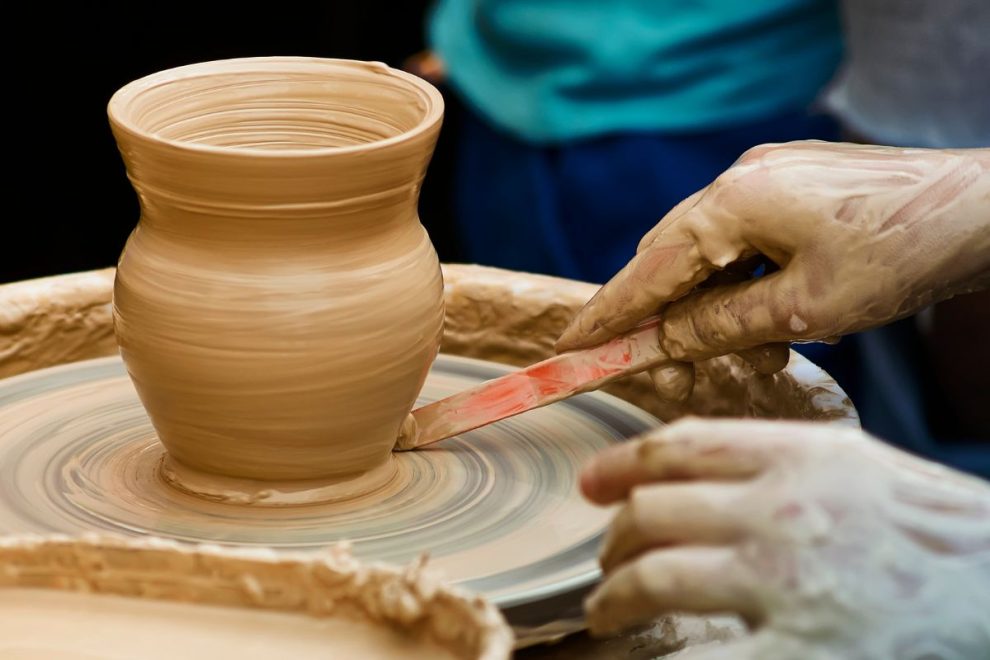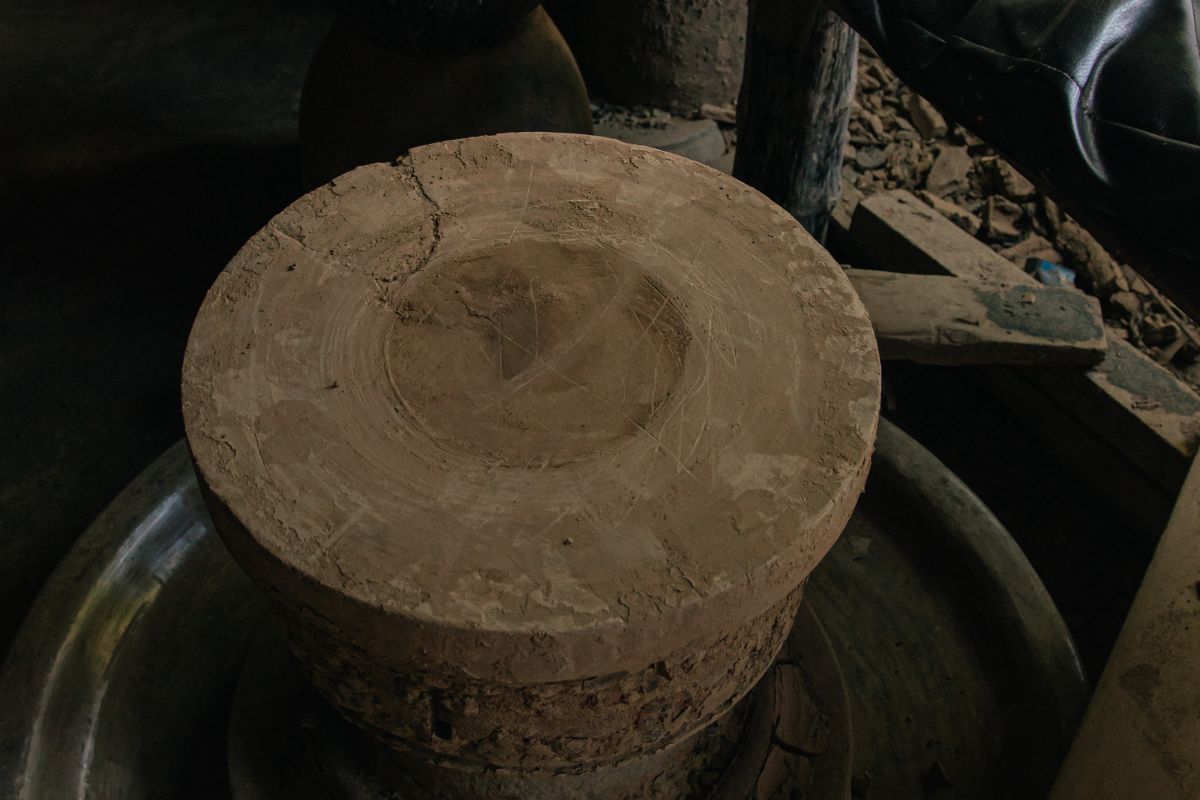
Learn how the ancient pottery wheel transformed early pottery-making and design.
Key Highlights
- The potter’s wheel revolutionized ceramics, enabling faster production of ceramic ware such as vases, bowls, and pots.
- Originally created by the Sumerians, the slow wheel preceded the fast wheel, which introduced throwing techniques.
- Ancient Greek pottery is iconic, with artistic designs shaped on potter’s wheels and often fired in kilns.
- The invention of the ancient pottery wheel spread across the Old World, transforming pottery-making in Egypt, Mesopotamia, and Europe.
- Modern advancements, like kick wheels and electric wheels, evolved from early mechanical pottery wheels with axles and bearings.
Pottery-making has always been important in human history. The potter’s wheel is important as it helps turn a lump of clay into many kinds of ceramic ware. Early tools like the ancient pottery wheel let people in ancient times make things such as vases, bowls, and plates. This helped bring in new ways to be creative and make useful things. In ancient Greek pottery, the use of the potter’s wheel was very important. Bowls and other decorative vessels from ancient Greek times show what can be made when people use a wheel to shape pottery. This article will take you back to learn about how pottery wheels began and changed over time.
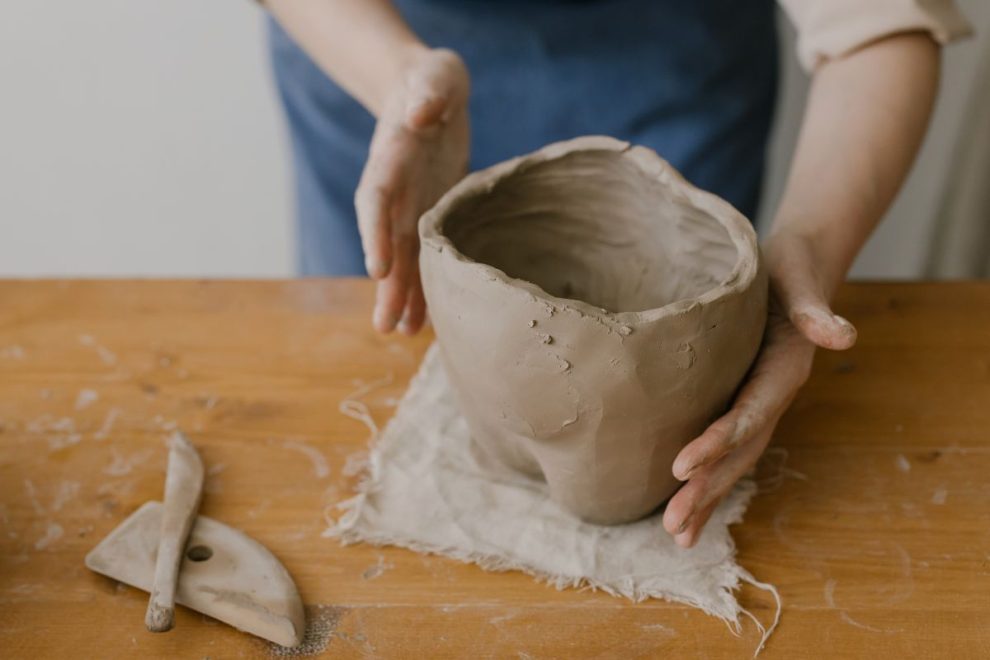
Origins of Early Pottery Making
Thousands of years ago, people made pottery without the potter’s wheel. Early humans used their hands and simple tools, like animal bones, to shape clay. They made basic but useful pots that they used for storage and cooking. Many of these items have been found by people doing excavations. These finds show us how simple early pottery-making used to be.
The old way of making pottery gave the world a starting point. It helped lead to new ideas, like the potter’s wheel, which changed the way pottery was made. Now, let’s look closer at the methods used before the potter’s wheel came along.
Hand-Building Techniques Before the Wheel
A long time ago, before wheels were made, people used the coiling method to make clay pots. The potter would roll clay into coils and then stack them on top of each other. By doing this, they could make a variety of pottery shapes. The hands of the potter were the main tool used, so there was no need for any spinning equipment. This showed a lot of creativity.
Potters would usually work on flat ground. They would often use large leaves or mats to help while working. Sometimes, the marks from the leaves or mats stayed on the bottom of the clay. This gives us a look into how things were made in those days. Potters could turn the vessel with their hands, making it simple to add coils to each part. This meant they did not have to walk around the pot.
Back then, the hands of the potter did all the work. There were no machines to help. These ways of making pottery showed great skill and new ideas. Later on, the invention of the wheel would change how pots were made.
The First Clay Artifacts and Their Uses
The first clay artifacts go back many thousands of years. People have found old pieces of pottery, showing that early humans used both fire and clay. Archaeologists have seen ways of firing that made the clay hard and helped it last a long time.
Early pottery included items like small bowls, cooking tools, and storage pots. These things were made for daily needs. They were not decorative but made for basic use, mostly for survival. People fired the clay in open pits, and this simple way led others to make better methods later on.
Pottery tells us a lot about the cultures from the past, because it often stays safe and is found in excavations. When archaeologists study these, they can see how pottery changed with time, moving from plain clay things to more detailed pottery in later years. As time goes on, the potter’s wheel starts to play a bigger part and helps show how the potter helped push cultures forward.
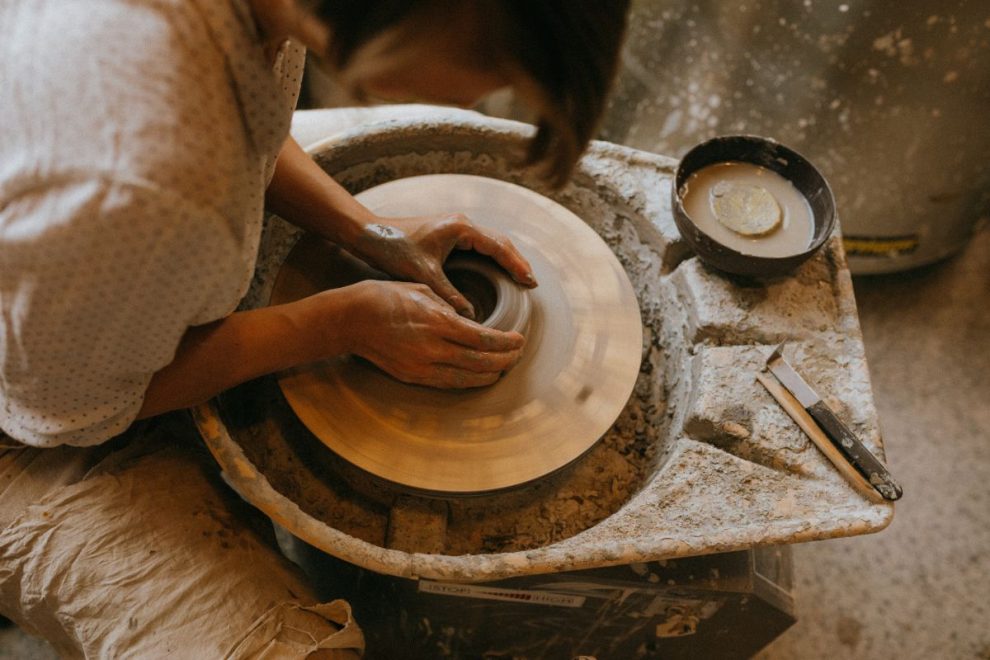
The Invention and Spread of the Pottery Wheel
The invention of the potter’s wheel was a big point in the history of pottery. The first potter’s wheel was made and used by the Sumerians in ancient Mesopotamia around 4000 BC. This change helped people make more even and detailed pots. The potter’s wheel let potters do more, and it made their work better than before.
From Mesopotamia, the use of the potter’s wheel spread into the old world, reaching places like Egypt and China. As time went on, people made slow wheels and fast wheels for pottery. These new types of wheels changed how pots were made across many lands and the way people saw pottery.
Ancient Mesopotamia and the Birth of the Wheel
In Mesopotamia, the Sumerians were the first to use a rotating platform to shape pottery. This tool became known later as the mechanical potter’s wheel. Around 3500 BC, people started using basic wheels with long shafts. This was an early sign of change.
Over time, the potter’s wheel design got better. Heavier flywheels were set at ground level. Potters could spin these flywheels by kicking them. This made the wheel move smoothly on its own. The new way let a potter make thinner pieces of pottery. The work also became more even and neat. There is proof that both slow and fast types of wheels were in use back then.
The creation of the mechanical potter’s wheel made pottery in the old world much easier and faster to produce. Many people in Mesopotamia used this to make more pottery. This new way of working gave potters in the old world the chance to create many new designs.
How the Pottery Wheel Transformed Pottery Production
The potter’s wheel changed the way people make pottery. It helped the potter work faster and with more care. The flywheel made the wheel turn smoothly with stored energy. This made it possible to make large pots. The potter can control the pot’s diameter. He uses his right hand and his left hand at the same time to shape the clay.
Now, people do not have to shape each pot by hand so much. With the wheel, artisans can spend more time on new designs. They can make different shapes like bowls with curved sides and skinny stemmed vessels.
Pottery production got quicker and easier because of this wheel. It also let the potter make things that all look the same. Making ceramic ware in a way that is steady helped pottery grow in both business and art. This tool became really important for all types of pottery and ceramic ware.
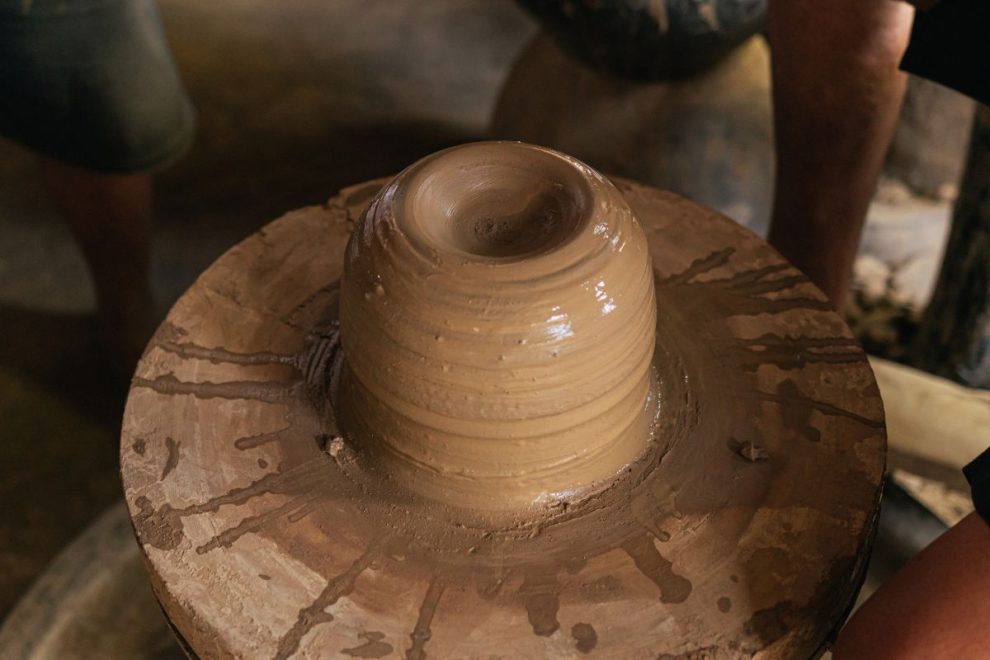
How did Ancient Pottery Wheels Work?
Ancient potter’s wheels used simple ideas that worked well. The potter turned the wheel by spinning a flywheel. Friction between the flywheel and the wheel head helped the potter control speed and how the clay moved.
Energy saved in the outside part, the flywheel, let the potter shape the pottery as they wanted. The hands of the potter could change how soft the clay was and keep it even, while making sure the wheel kept spinning. Some of these wheels had shafts to help keep them more stable.
This setup was very good for the time. It shows how one smart tool changed the way people made pottery. The things used and the ways of working all helped when someone wanted to make great pottery.
Primary Materials used for Ancient Pottery?
| Material | Details |
| Clay | Clay is the main material used in pottery. You can shape it in many ways. |
| Terracotta | This is a type of clay that takes in water. People use it to make strong ceramics. It often needs low heat for firing. |
| Glazes | Glazes go on pottery to cover the surface. They make it colorful and stop water from getting in. |
| Porcelain | Porcelain is a fine kind of clay. When you fire it at high heat, it becomes see-through and smooth. |
| Consistency | Consistency matters a lot. Potters need to spread the clay out evenly when they knead and get it ready. |
These materials were key for ancient pottery. They helped people make ceramics and ware that worked well and looked good.
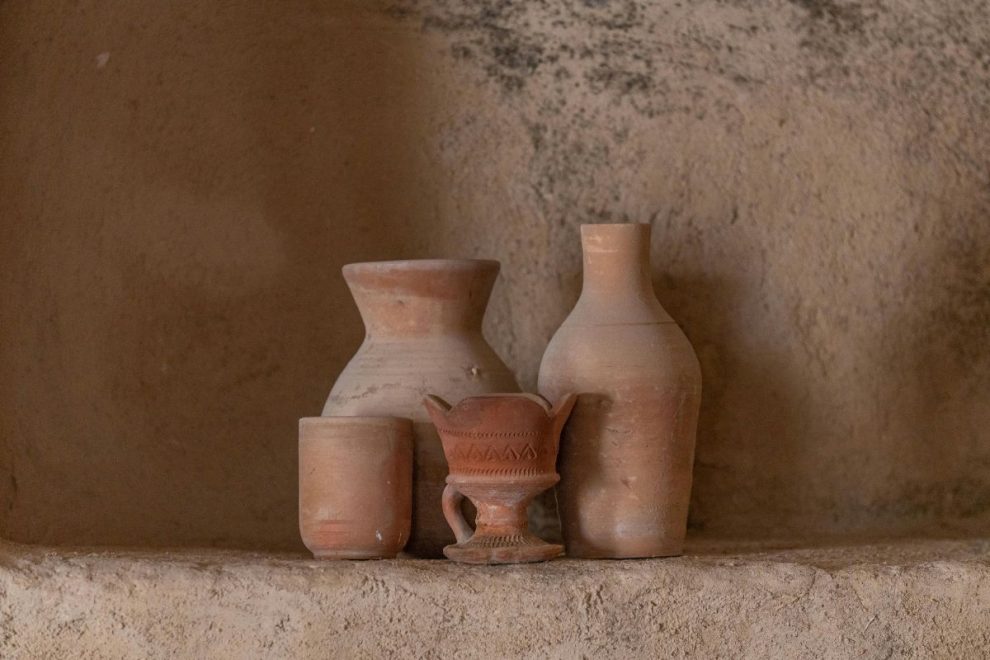
Significance of Ancient Pottery Wheels in Ancient Civilizations
The potter’s wheel was very important in old times. It helped potters make more ceramic ware as people wanted more pottery. People used methods like coiling and firing. With these, a skilled potter could make many kinds of pottery fast.
Many places used the pottery wheel, like Mesopotamia, Ancient Greece, and Egypt. This shows how important it was in their lives. The pottery wheel was not just for making things people needed. It also became a way for potters to make art and show their own ideas. Next, we can see how different groups used pottery wheel skills in their own way.
Pottery in Ancient Egypt and the Near East
Egyptians became very skilled in pottery. They got really good at making nice-looking ware and had smart ways for firing their pots. The kiln was important for them because it let them fire pottery at high heat and use different glazes. The use of the potter’s wheel let them make detailed storage pots that people used every day.
Egyptian potters liked to use designs that looked the same on each side and bright colors. They would use firing to make each piece have its own look. The first tools for this work in Egypt were turntables. These tools later changed and became shafted wheels.
In the Near East, people began to use the same kind of work and tools. This spread new kiln designs and better pottery skills to other cultures.
The Potter’s Wheel in Greek and Roman Societies
Ancient Greece was known for its pottery. People there used the wheel to make vases and other vessels in the old way. Famous styles from this time were black-figure and red-figure ceramics. These showed scenes from old Greek stories and myths.
The Romans took these ideas and evolved them. They used a variety of ways to make pottery. Most of the time, they focused on making things to use, not just to look good. Potters in both ancient Greece and Rome used wheels. This helped them make more ceramic ware, with each piece looking the same as the others.
Later on, Europe picked up these habits. People in Europe turned pottery and ceramics into a new kind of art. The pottery from Europe began to show off each group’s own culture and ideas. This showed how pottery and ceramics could change with time and place.
Evolution of Pottery Wheel Technology
The way the pottery wheel has changed over time is really impressive. People started by using their hands to turn the wheel. Then, new things like metal bearings made it smoother and easier to use. After that, older types changed to kick wheels and then electric wheels that have levers. These levers help you control how the wheel moves.
Now, there are new features that make doing pottery much faster. You can adjust the speed, and the wheels are stronger than before. These changes make today’s pottery wheels very useful to have. They show how making pottery has changed. Let’s look deeper at how pottery wheel designs are different from one another.
Differences Between Slow and Fast Wheels
Slow wheels were one of the first ideas for making pottery. They turned by hand and sat on a platform close to the ground. These wheels were heavy and hard to use. People used them to shape simple pots.
Fast wheels brought in the use of a flywheel and spun quickly on an axle. This type of wheel made rotation take less work. Potters could use this tool to make better designs. They could also shape jars or bowls that were even and smooth.
When people look at slow wheels next to fast wheels, they see big changes. New technology helped make pottery faster and more regular. Many potters in the past moved to fast wheels to keep up with the need for speed and sameness.
Advancements Leading to Modern Wheels
Modern wheels show the progress of hundreds of years. The kick wheel, which came out in the 16th century, used shafts at ground level to help it spin. There have also been changes in what wheels are made of. People started with wood, but now they use metal bearings. This made wheels last longer and work better.
In the 19th century, people started to use electric pottery wheels. These new wheels made making pottery less hard on the potter. That’s also when gas kilns started to be used. These kilns took the place of old fire pits, giving better and more even firing and great consistency.
Now, modern potter’s wheels let you adjust the speed and use automatic rotation settings. All these advances make these wheels tools that both people new to pottery and skilled potters use every day.
The pottery wheel changed the way people made pottery. It helped shape many of the world’s earliest societies. The first ancient pottery wheel started in Mesopotamia, and over time, it spread to other places. People used the pottery wheel to make more pots and better designs, which also helped in trade and everyday life. Learning how the pottery wheel began helps us see how people built new tools and found ways to be creative. This shows that great ideas often come from simple needs. It also lets us see how people pulled the old and the new together to make something unique in their world. If you want to learn more about pottery, you can look for workshops or classes near you. This could be a good way to start your own creative journey.

